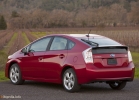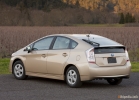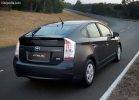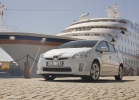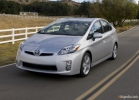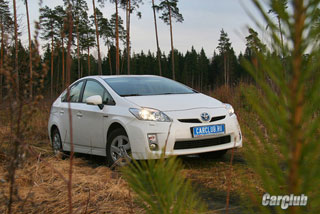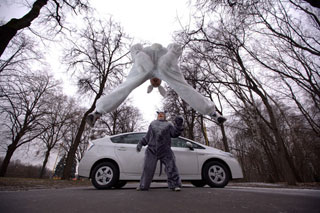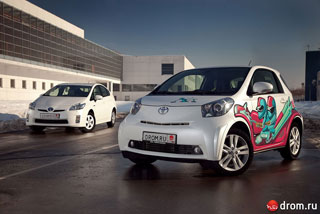Toyota Prius test drive since 2009 hatchback
Toyota Prius. Japanese hematogen
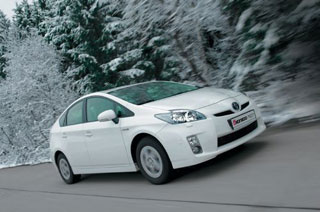 Toyota Prius. Price: from 1 177 000 rub. On sale: since October 2009
Toyota Prius. Price: from 1 177 000 rub. On sale: since October 2009 Toyota Prius is rightfully considered the bestseller of the hybrid market. The first two generations of the compact sedan diverged in the world with a record circulation of 1.2 million cars. It seems that the third -generation of Prius grain falls into fertile soil, the more, the novelty promises to be more powerful and even more economical. Is it so? Let's go to the training ground and weigh all the pros and cons of
Test pilot
Vladimir Makkaveev, 32 years old, automobile journalist, driving experience 13 years old, personal car - Volvo C30
Only hot rays of hybrid glory to collect record harvests today is not enough today. Hybrids gradually cease to be white crows of automobile society. You will not surprise anyone with blue hybrid nameplates and high messages of unearthly economy today. There is now little consciousness of the only usefulness of hybrid chocolate. They want this chocolate to be sweet or, at worst, bitter, but have at least some taste. And just with taste qualities, Toyota Prius had problems. Being one of the most useful cars of the planet in terms of worries about the environment and the health of the driver’s wallet, the second generation Prius was absolutely tasteless in terms of controllability. He brought the pleasure of driving a little more golf car. And from the minimalist decoration of the salon, the salon was sleeping. It is not surprising that the Japanese paid so much attention to the taste of their hematogen when developing the third generation Prius.
The exterior of Prius has changed slightly, preserving the main family features of the previous generation. But the decoration of the salon in comparison with the last version is simply heaven and earth. The driver’s place and the central console look much more modern, reminiscent of the control panel of the compact helicopter. The dashboard, which has moved to the information monitor with data on the operation of the hybrid power plant, became more technological in order. Even two -layer micronitors appeared, displaying information on top of the main panel. Naturally, the previous generation of Prius about such a technological feast did not have to dream. But in this case, the Japanese, perhaps, still overdid it a little. Due to the dominance of high-tech, the boring minimalism of the second generation Prius was replaced by cold conciseness with dry pile of devices and dubious ergonomics.
But all these little things can be closed by your eyes, because with the main problem of Prius II hopelessly imposing control control in Toyota still figured out. Of course, Prius did not turn into a sports car, but he made a step forward compared to his predecessor. The Japanese hybrid finally learned to bring at least some pleasure from driving.
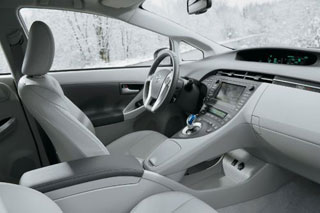 The steering wheel with an electric servo acquired excellent feedback, became much denser and more acute in reactions. Course stability has increased markedly. Add to this very productive brakes, and you will receive a portrait of a quite modern front -wheel drive car. Unless the back is hard, which causes quite specific behavior in corners, but there is no getting away from this, because there is a ballast in the trunk in the form of huge nickel-metallogid batteries that feed the 82-horsepower electric motor. Due to the larger load on the rear axle, the suspension is slightly tougher than that of most gasoline competitors, but it practices its purpose quite worthy. The language will not turn to blame Prius of a low level of road comfort. What can not be said about acoustic comfort. Despite the small factor coefficient (0.25), a rising air flow at high speed creates a tangible noise, and the sound insulation of the wheel arches leaves much to be desired: the dialogue of the tires with asphalt is heard in the cabin very clearly. The same applies to the arrogant rumble of a gasoline engine.
The steering wheel with an electric servo acquired excellent feedback, became much denser and more acute in reactions. Course stability has increased markedly. Add to this very productive brakes, and you will receive a portrait of a quite modern front -wheel drive car. Unless the back is hard, which causes quite specific behavior in corners, but there is no getting away from this, because there is a ballast in the trunk in the form of huge nickel-metallogid batteries that feed the 82-horsepower electric motor. Due to the larger load on the rear axle, the suspension is slightly tougher than that of most gasoline competitors, but it practices its purpose quite worthy. The language will not turn to blame Prius of a low level of road comfort. What can not be said about acoustic comfort. Despite the small factor coefficient (0.25), a rising air flow at high speed creates a tangible noise, and the sound insulation of the wheel arches leaves much to be desired: the dialogue of the tires with asphalt is heard in the cabin very clearly. The same applies to the arrogant rumble of a gasoline engine. Having on the bottoms of an effective assistant in the form of an electric motor, the Prius gasoline engine, like most of his hybrid counterparts, works on the principle of Atkinson. Changing the phases of gas distribution of inlet valves increases high speed efficiency without the need to enrich the combustible mixture. All this reduces CO2 emissions to a record marks 90 g/km and saves fuel. But Atkinson’s cycle stick about the two -edges, preventing the growth of torque at low speeds. The hybrid drive fully compensates for this drawback, however, the process of connecting to the operation of the gasoline engine seems too protracted. Due to the pro -economical and procologic settings of two of the three drive modes selected from the console, even in the presence of unavailable automation, the reaction of a 1.8 -liter ICE to the commands of a long -flowing gas pedal is stretched for several languid seconds. True, there is another Power mode, squeezing the maximum from the gasoline engine. But, firstly, it is fraught with a noticeable increase in fuel consumption, completely killing the consumer advantages of a hybrid drive. Secondly, with the complete opening of the gas, 136 horses lurking in two engines of the hybrid power plant emit such a wild neighing that the driver involuntarily overwhelms the alarm for the health of the herd. This howl sounds like a shinger. And here it is already not clear who is trained. Even the hottest drivers Prius are able to accustom to a measured, maximum effective manner of piloting, in which each pressing of the gas pedal is responded with inevitable remorse. Learn to save! yells the internal combustion engine Prius. After a couple of days, I don’t want to think about the Power button.
Given the above verdict, an excellent city car suggests itself, if not one significant lack for the city hatchback. The overview of the new Prius, as, indeed, his predecessor, leaves much to be desired. And this is still mildly said. The parking camera, of course, slightly smooths out the situation, but even with it maneuvers in a limited space are given by Prius through force. However, mediocre visibility and noise by and large, the only frank places of the most environmentally friendly and budget hybrid of the planet.
Three lives Prius
Unlike most other hybrids, Prius is surprisingly adaptive. He willingly listen to the driver's desires in terms of choosing a drive, allowing you to change the modes of movement by pressing the corresponding button on the central console. The ECO mode, which automatically turns on after the start, allows you to achieve the perfect compromise of the speed and fuel consumption. In the EV Prius mode, it works on pure electricity, but this ode of economy lasts exactly as much as the battery charge allows: in theory up to 1.5 km at speeds up to 45 km/h, although we could not overcome more than 1 in this mode, 2 km. The third lifestyle of Prius PWR, on the contrary, noticeably exacerbates the reactions of the internal combustion engine, equally increasing both the temperament of the car and the fuel consumption.
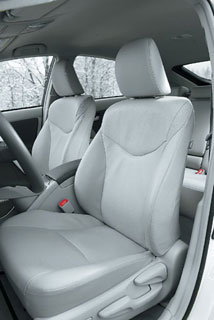 Details
Details Navigation is not the most outstanding from the point of view of artistic aesthetics, but practical and allows you to register routes. Practical
A record low number of emissions CO2 is a consequence of a successful combination of a gasoline engine and electric motor. Purely
Our assessment
In terms of environmental friendliness, Toyota Prius III knows no equal. At the same time, in comparison with the predecessor, the car has become a little more economical and an order of magnitude better.
Body
+ spacious salon, solid trunk
- Poor visibility
Driving comfort
+ comfortable suspension, comfortable seats
- Weak sound insulation of wheeled arches
Power unit
+ high efficiency, low consumption
- High noise level
Cherry properties
+ good course stability, decent controllability, dense steering wheel
- congenital insufficient rotation
Security
+ reliable brakes, good security level
Environmental friendliness
+ minimum emissions CO2
Author: Vladimir Makkaveev
Photo: Sergey Krestov
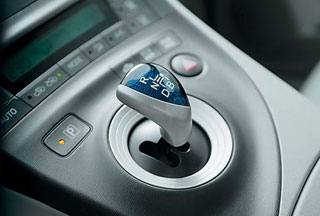
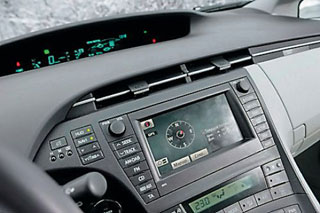
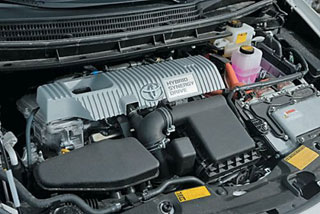
A source: Magazine 5 wheel [January 2010]

